 The enjoyable moments of day-to-day life A question of activities - and their context
The enjoyable moments of day-to-day life A question of activities - and their context
The daily activities which we most enjoy are those associated with free time. It is particularly enjoyable to go for a walk or take part in artistic and cultural activities, sports and games ; a little less enjoyable to surf the internet or watch television. Sleeping and sharing a meal with friends and family are also very enjoyable activities. On the other hand, activities such as studying, working or treating an illness are considered less enjoyable. Context plays a decisive role in our opinion of an activity : for example, making a journey alone is disagreeable ; making a journey with company is much more enjoyable. And of course a bit of sunshine really can brighten up your day.
- A day in the life: a play in five acts
- Television, one of the least enjoyable leisure activities
- Mealtimes, a moment to savour
- The tighter our schedules, the more we resent domestic tasks
- Journeys made by bicycle are the most enjoyable
- The self-employed get more satisfaction out of work than employees
- Weekends are the most enjoyable days
- Enjoyment of time
- Daily average and general subjective well-being
A day in the life: a play in five acts
We can divide the average day into five major phases : time devoted to physiological necessities (sleeping, washing, eating), time spent working, time spent doing domestic tasks, time spent travelling and, last but not least, the time left over after these four necessities - free time. The activities we enjoy the most are those associated with our free time (see Graph 1). Physiological necessities are also considered to be enjoyable experiences. Time spent travelling and time spent performing domestic chores are next in the appreciation stakes, but they fall far behind our enjoyment of leisure activities and physiological functions. Finally, time spent working or studying is generally the time we least enjoy (Box 1).
graphiqueGraphique 1 – Free time is the most enjoyable time
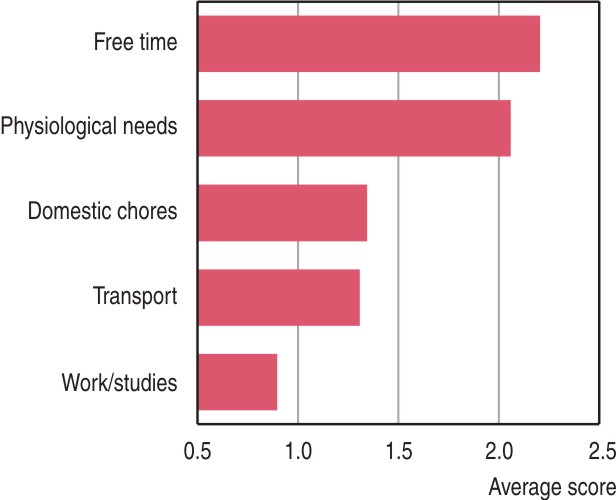
- How to read it: the average score for free time activities is +2.2 on the scale of enjoyable moments.
- Source: Insee, 2010 Time Use Survey.
Television, one of the least enjoyable leisure activities
Broadly speaking, periods of free time are the most enjoyable moments of the day, with an average rating of +2.2 (the scale runs from -3 to +3), but our appreciation of our free time varies according to the activities to which it is devoted. Free time activities can be divided into two main categories : the first covers social activities (conversations, religious practices, clubs and associations), with the second including all leisure activities (watching television, playing games, sport). DIY and gardening are quasi-leisure activities, and for the purposes of this study are classed as domestic tasks.
Only people engaging in a leisure activity can decide whether that activity is enjoyable or not. The enjoyable nature of a period of free time does not depend upon whether that time is spent alone or in company. Outdoor activities such as walking or going to the beach are among the activities judged to be the most enjoyable by those engaging in them (see Graph 2), particularly by women (receiving an average rating of +2.6, compared to +2.4 from men).
People who engage in artistic activities, such as singing in a choir or taking dance lessons, rate these activities highly. Watching television takes up on average 42 % of our free time, but time spent in front of the screen does not rank among the most enjoyable leisure activities, regardless of age, socio-professional category or gender. Only the most dedicated television-watchers (people who watch an average of more than 4 hours of television every day) particularly enjoy this activity (+2.2 average rating, while the average among people who watch less TV is +2.0).
The average rating attributed to time spent on the internet or on the computer is only slightly higher than that accorded to television viewing, despite the fact that the time devoted to such activities continues to grow (the average time devoted to these activities across the whole population is 15 minutes per day).
Social activities involving a degree of responsibility, such as supervising a polling station or doing voluntary secretarial work for a club, are the free time activities deemed least enjoyable.
graphiqueGraphique 2 – Enjoyment of different free-time activities
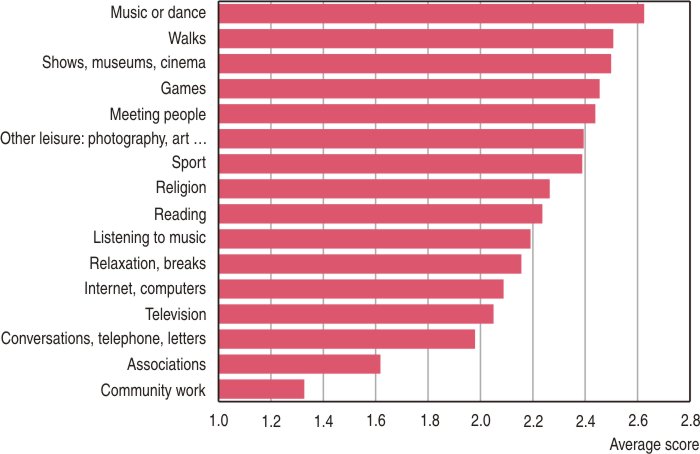
- How to read it: the average score associated with music and dance activities is +2.6.
- Source: Insee, 2010 Time Use Survey..
Mealtimes, a moment to savour
Although the average time spent sleeping has been declining over the past twenty years, sleep is still considered enjoyable (see Graph 3). The ratings attributed to by both sexes and across the different age categories show little variation. It is those people who find other activities encroaching upon their sleep time who most appreciate the time they do get to spend in bed.
Mealtimes are considered to be enjoyable moments, particularly when they involve guests from outside the household. This spike in enjoyment is more notable in women than it is in men. The people who most enjoy moments relating to mealtimes are those who devote the most time to such moments.
Although the time devoted to dressing and taking care of one's appearance has increased by fifteen minutes per day over the last decade, women still derive little pleasure from such activities - though they still rate it more highly than men. Administering medicines or care is held to be very disagreeable, as such activities are linked to health problems (rating of around 0).
graphiqueGraphique 3 – Medical treatment is the least enjoyable part of physiological needs
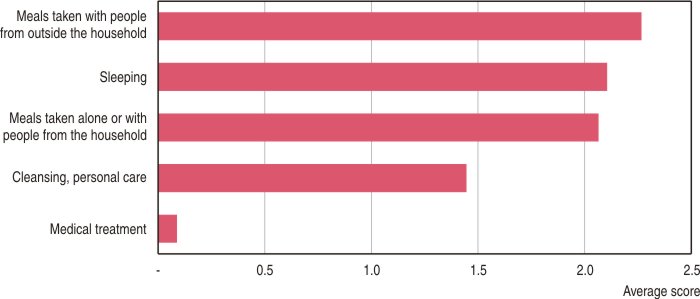
- How to read it: the average score associated with meals taken with people from outside the household is +2.3.
- Source: Insee, 2010 Time Use Survey.
The tighter our schedules, the more we resent domestic tasks
The most enjoyable domestic tasks are taking care of children or taking care of animals (see Graph 4). Quasi-leisure activities such as gardening and DIY rank among the domestic tasks we most enjoy, but their average appreciation ratings are still inferior to those given to free-time activities. Shopping and cooking come next. Finally, household chores are deemed to be the least enjoyable domestic activities, particularly those involving laundry, cleaning or administrative formalities. Shortage of time has a great influence on the way people perceive domestic tasks : people who are often short of time rank domestic chores at 1.1 on the enjoyment scale, while the average is 1.4 among people with fewer time constraints. Thus housewives and retired people find household tasks less unpleasant and spend more time on them that people in employment or education : 35 % of working people say they feel time pressure every day, compared to 9 % of retirees and 17 % of housewives. It is possible that women who have made a decision not to work find performing domestic duties less disagreeable than women who have jobs. Nonetheless, despite the fact that women devote an average of 100 minutes more to domestic duties than men do, they do not find these tasks any more enjoyable than their male counterparts.
graphiqueGraphique 4 – Quasi-leisure and care are the most enjoyable part of domestic chores
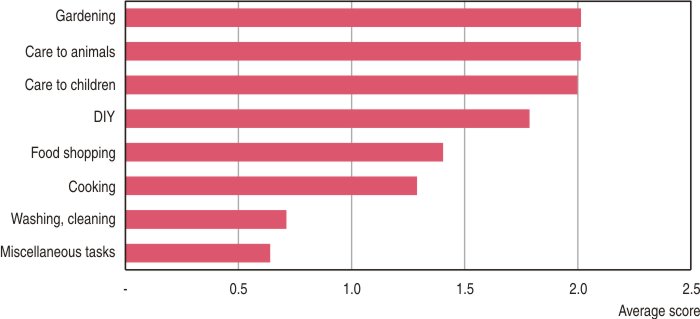
- How to read it: the average score associated with gardening is +2.
- Source: Insee, 2010 Time Use Survey.
Journeys made by bicycle are the most enjoyable
The time spent travelling is seen as a burden by those people who say they are often in a hurry (+1.2 against +1.5 for people with fewer time constraints).
Irrespective of the length of travelling time, whether or not a journey is pleasant is strongly dependent on its purpose (Graph 5). A journey is not an end in itself but a necessity for the fulfilment of numerous activities. Commuting is thus judged to be the least agreeable journey, even though commuters can read or listen to music as they travel. Even here there are nuances. The journey into work is enjoyed even less (+0.7) than the trip back home (+1.5). Trips to get to an association or to help other households are the ones most positively experienced.
Irrespective of the purpose of the trip, walking and cycling are far more enjoyable than driving or taking public transport. Lastly, travelling with someone makes the journey more enjoyable (+1.5 against +1.2 for a journey alone).
graphiqueGraphique 5 – Enjoyment of journeys varies according to the purpose of the trip
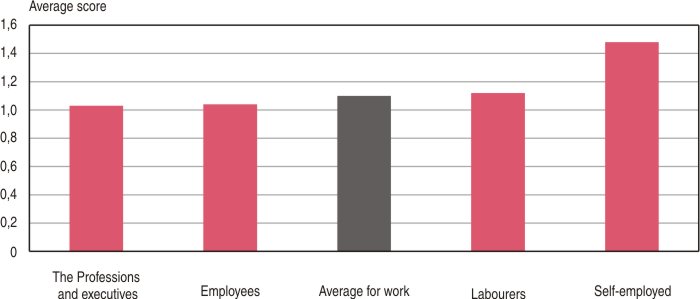
- How to read it: the average score associated with journey to get to an association or to help another household is +1.6.
- Source: Insee, 2010 Time Use Survey.
The self-employed get more satisfaction out of work than employees
The activities considered as least enjoyable are those related to work or studies, with an average ranking of zero, although they do not prejudice general well-being (Box 2). The youngest school pupils like study periods the least, and appreciation of study time increases with age (although these results should be treated with caution due to the low number of observations). This may be explained by the fact that the young people who least enjoy school are those who are least inclined to continue their studies.
Self-employed people enjoy the time spent on their professional activity more than employees (Graph 6). Among employees, there is little difference in enjoyment levels according to hierarchical position or the status of their employer (public/private). Working outside home or at home does not change the level of enjoyment of professional tasks.
The more people say they are tired at the end of the day, the less they enjoy the time devoted to work, particularly when the tiredness is due to the atmosphere at work. Unlike with domestic tasks, being short of time has no influence on their judgement. Lastly, the two extremes are in agreement : the judgement is even more negative when the working day is very short or very long.
Weekends are the most enjoyable days
The average level of enjoyment of a day is the result of all the effects highlighted above (Box 2). Working days are those that are enjoyed the least (Graph 7). Retired people show no difference in satisfaction between these days and the weekends. It is also observed that the scores are higher in July and August, usually the months where people work the least, than in the other months of the year.
Lastly, on average, a day is considered more enjoyable when the weather is clement. This is not only linked to the summer : the nice-weather effect remains constant independently of the day of the week, the month, and whether the day under consideration is a working day or not.
Enjoyment of time
In the Time Use Survey, respondents have to fill out a daily log describing their activities in 10-minute time steps : what they do, with whom, where, for what purpose, and whether they do something else at the same time. Further to the report by the "Stiglitz" Commission which recommended developing instruments for the statistical measurement of the subjective well-being of the population, from 2010 these surveys also had to give a score of between -3 and +3 indicating whether the time spent was enjoyable or not, taking into account the activity itself but also the context. The consideration of the context in which an activity is carried out is decisive in this appraisal : the same person may rank the same activity differently. For example, a bus journey may be experienced as more or less enjoyable depending on whether the person is seated or standing. Similarly, enjoyment of a match on TV may vary according to the score.
Lastly, time is not a storable resource and this is what makes its use so particular. While nothing obliges us to buy a good that we do not want, there are certain activities which are necessary for the human machine to function and which are difficult to postpone. The fact of having to sleep may be seen as irksome if the person still has tasks to accomplish, but a long night may be greatly appreciated if the person can take the time to do so. In order to understand whether people are short of time and thus need to reduce their sleeping time, or on the contrary have free time and do not know what to do with it, questions are posed about the use of time. For example, it has been noted that when people regularly have free time in which they do not know what to do, this has no bearing on the enjoyment of activities.
Daily average and general subjective well-being
It is possible to compare the enjoyable aspect of the day described with the general response to satisfaction with life :
- Each 10-minute period was ranked from -3 to +3 by respondents, and the daily average was calculated by assigning the same importance to each period irrespective of activity and context ;
- Enjoyment of life in general is the answer to the question : "On a scale of 0 (not at all satisfied) to 10 (very satisfied), how satisfied are you with the life you lead at present ?"
It is observed that the more satisfied individuals are with their life in general, the higher the average of the day described.
However, this positive link is not true across all groups. For example, people aged under 20 give a negative judgement of their study time, which mechanically leads to a low daily average. But when asked about their general satisfaction with life, they are very happy (8.4 for satisfaction against an average of 7.4). So they do not enjoy study time but only accord a low level of importance to it in their general well-being. Similarly, as work is not considered as a very enjoyable activity, people with a job spend slightly less enjoyable days than the unemployed (+1.8 against +1.9) ; however, their satisfaction with life is far higher than that of the unemployed (7.4 against 6.0).
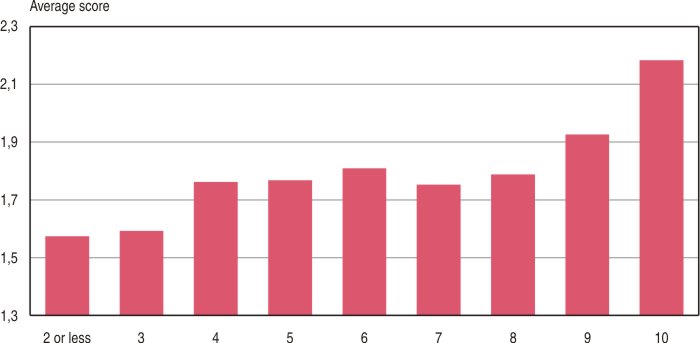
- How to read it: The average score associated with the people who gave 2 or less in answer to the question of enjoyment in life in general is 1.6
- Source: Insee, 2010 Time Use Survey
Sources
The 2010 Time Use Survey conducted by INSEE was carried out from September 2009 to September 2010. Between March 2010 and September 2010, a subsample of respondents (aged 11 or over) filled out two logs describing their activities and their enjoyment of time spent in 10-minute time steps over a full day (weekday and weekend day). 1,661 individuals responded and 2,665 logs were completed.
Définitions
Principal activity : unless otherwise mentioned in the study of journey times, the durations given refer to respondents' principal activities, i.e. the activity they selected as the most important if they were performing several activities simultaneously (e.g. eating while watching the television).
Average rating : the same activity may be repeated several times in the course of a single day (for example, we eat several meals). The scores given here are averages of the ratings given for these activities at different times of the day.
Pour en savoir plus
'Over the last eleven years : fewer chores, more internet' ; Insee Première n°1377, November 2011.
'Does happiness wait for the right time ?' ; France Portrait Social,Insee Références 2008 edition.
'Life satisfaction : average rating of 7 out of 10' ; France Portrait Social, Insee Références 2011 edition.




